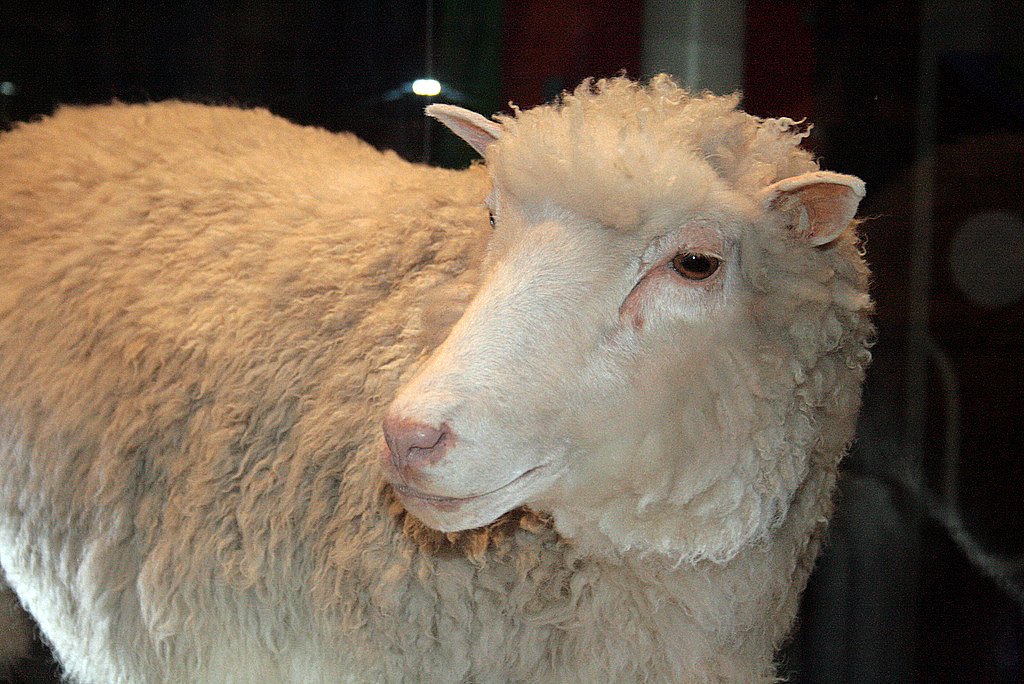
Foto: Close up of Dolly (taxidermy)
Source: T.Barros/Wikimedia
Name: 6LL3, known as Dolly
Famous because: the first mammal cloned from an adult cell
Current location: National Museum of Scotland, stuffed
This sheep was born a star. On July 5,
1996, Dolly was born just as all lambs are. However, she had been created five months earlier in a test tube as sample 6LL3. She developed from the genetic material of a body cell, not from a fertilized egg cell. Dolly was therefore the first copy of an adult sheep. And the excitement was huge. (...)
The opportunities offered by cloning had been overestimated
Proponents of technology hoped for cures for diseases such as cancer or Alzheimer's through cloning. Sceptics, on the other hand, warned of a horror-film technology that could one day lead to the mass production of cloned people. This much we now know: The risks and opportunities of the technology had been greatly overestimated. (...)
In a nutshell, the cell nucleus transfer method can be described as follows: The researchers took an oocyte, i.e. an unfertilized egg, and removed the chromosomes. Then they took a complete cell containing both male and female chromosomes. They then fused the cell with the empty cell, stimulated growth and implanted it in a surrogate mother. (...)
The researchers claim to have transferred a total of 277 cell nuclei from a Finn Dorset sheep to the oocytes of a Scottish Blackface. Only 29 of the resulting embryos were implanted in the surrogate mother. Expectations were low, reports Nature: It seemed almost impossible for the nucleus of an adult cell to be reprogrammed such that a living animal would grow from it. Most of the cloned embryos died, many even before the researchers could confirm the pregnancy using ultrasound. In Dolly's case, however, all went well. At around 4:30 p.m. on July 5, 1996, the surrogate mother began contractions. Half an hour after the birth the doppelgänger sheep stood for the first time. (...)
The technology has hardly developed since then. It turned out to be generally useless. For example, in regenerative medicine, other methods are more promising; as a human reproductive technology, cloning is taboo worldwide – and in animals the success rate is rather low. In addition, clones appear to be vulnerable: Dolly died at the age of six from an incurable lung disease that usually only occurs in older animals.
Cloning is too expensive for mass production
Cloning is too expensive for mass production. Only for duplicating award-winning breeding animals has the cloning technique managed to make a foothold. Since mass production of cloned animals would be too expensive and time-consuming, industry relies more on cloning animals with extraordinary genes, which should then provide genetically high-quality offspring. While cloning for agriculture in the EU is subject to strict licensing regulations and is therefore not practiced, companies do use it in other countries. Interest in the USA is particularly great, where, in 2009, the FDA licensing agency found that the consumption of cloned farm animals was absolutely safe. There is no labelling obligation for meat or milk derived from cloned
animals. Since then, critics have feared that some products could end up undetected in the European market.
Finally, last year, the European Parliament demanded a far-reaching ban on cloning. This should not only apply to cloned animals themselves, but also to their offspring. It is also intended to prohibit
the import of products from clones, such as milk, as well as semen and ova from cloned breeding animals. A vote by the Council of Ministers, which has yet to reach a unified position, is still pending. Parliament and the Council of Ministers must then decide together. Twenty
years after Dolly's birth. Congratulations.
Shortened translated version of an article in: ZEIT ONLINE, dpa: 5. Juli 2016, 15:15 Uhr
Video: Dolly's 20th birthday
It's 20 years since Dolly made history, becoming the first mammal to be cloned from an adult cell. This procedure marked a breakthrough in genetic research and technology, paving the way for everything from 3D-printed meat to the possibility of resurrecting woolly mammoths, Tasmanian tigers and more.